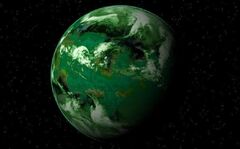
This is what chlorine planet may look like
Chlorine planet is a hypothetical class of planet with surface covered in lakes or oceans of muriatic acid with clouds made of muriatic acid in the atmosphere.
Appearance
Viewed from space, the oceans on chlorine planet would appear deep green as shown in the image, because microbes in the oceans metabolize and release chlorine, which is green. Lands would appear brownish to blackish green and clouds appear white with green tinge. The clouds formed when muriatic acid vapor condenses.
Atmosphere and climate
Chlorine planets tend to be smoggy and have precipitation but no thunderstorm. Unlike Earth, chlorine planets use muriatic acid as a "variable gas" instead of water as it is on Earth. For example, there are muriatic acid rain or muriatic acid snow instead of water rain or water snow. Those planets tend to be cold, at around −110°F (−79°C), about the sublimation point of carbon dioxide. Their atmospheres tend to be composed mostly of nitrogen (N2), oxygen (O2), and chlorine (Cl2) with variable amounts of muriatic acid vapor (HCl) and trace amounts of diclorine monoxide (Cl2O), carbon dioxide (CO2), mustard gas (C4H8Cl2S), and other gases.
Life
The life-bearing status on chlorine planets are fair, even though chlorine is toxic to many forms of life on Earth, but some forms of higher life somewhere in our galaxy require chlorine to thrive. It is predicted that during the photosynthesis, muriatic acid (HCl) is combined with carbon dioxide (CO2) to produce formaldehyde (CH2O), chlorine (Cl2), and oxygen (O2) using the balanced equation below:
- 4 HCl + 2 CO2 + energy → 2 CH2O + 2 Cl2 + O2.
It is also predicted that animals drink muriatic acid and eat foods rich in formaldehyde. Animals also inhale oxygen and exhale carbon dioxide like they do on Earth. The main biogeochemical cycle on chlorine planets is the chlorine cycle compared to the carbon cycle here on Earth.
Rarity
Chlorine planet is believed to be the rarest composition class of planet in the Milky Way galaxy because the element chlorine is rare in the universe, plus chlorine is extremely reactive. Out of estimated 820 billion planets (524 billion terrestrial planets) in our galaxy, there are only about 3 million chlorine planets, that's about 1 per 160,000 terrestrial planets and 1 per 260,000 total planets!
Related links
- Dazbog –– an article on NukeVac Wikia about a chlorine planet
- Hypothetical types of biochemistry
External links
| ||||||||||||||